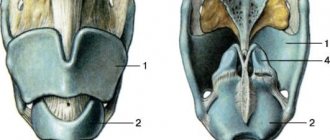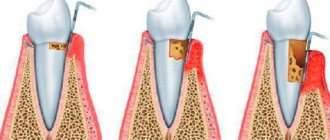The larynx or throat is the part of the respiratory system that connects the pharynx to the trachea. It allows a person to reproduce sounds and is located at the level of the 4th–6th cervical vertebrae. The larynx is a mobile formation connected by ligaments, membranes and joints, and its frame consists of cartilage tissue and is not protected by bone tissue, so it can be easily damaged.
Injury to the larynx can result from both internal and external causes. Any damage to an organ is accompanied by pain, often quite severe. Depending on the type and extent of damage to the larynx, a person may experience breathing problems, dysphagia, dysphonia, internal or external bleeding, coughing, or other problems.
Types of laryngeal injuries
External damage to the larynx occurs as a result of blunt trauma to the larynx, which occurs after strangulation, blow with a blunt object, fist or piercing object, car accident, etc. Blunt trauma can very often be combined, i.e. complicated by fractures of the cartilages that make up the larynx and ruptures of the vocal cords, tendons, and severe bleeding.
The cause of internal damage can be various medical manipulations on the organ, this is especially often caused by tracheal intubation, endoscopic examination of the bronchi and lungs, connection to a ventilator, etc. The organ can be injured by a foreign body with sharp and cutting edges that enters the larynx. Damage to the inner lining of not only the larynx, but also other parts of the respiratory system, can cause inhalation of toxic gases or too hot air. Severe coughing and screaming can also cause internal damage to the organ. Laryngeal injuries are divided into domestic, industrial and military.
Symptoms of laryngeal damage
Symptoms vary in the degree of damage to the organ structure and how extensive it is. The main and most dangerous sign of organ injury is deterioration or cessation of respiratory function. In this case, breathing disturbance can be immediate, i.e. appear immediately after injury and indirectly, arising as a result of pathological edema, hematoma or organ infiltration.
In addition, trauma to the larynx provokes other disorders:
- Complete or partial loss of voice
- Swallowing disorders
- Pain syndromes of varying severity
- Cough, sore throat
- Internal or external bleeding
- Laryngeal nerve paralysis
- Hematoma formation and laryngeal edema
The danger of laryngeal injuries is fraught with the development of various complications - from post-traumatic shock, laryngeal stenosis, to the development of infectious and inflammatory processes. The most dangerous complication is asphyxia, in which the patient must be immediately connected to a ventilator.
Diagnosis of the disease
With laryngeal injuries, you should seek emergency medical help as soon as possible. External examination and palpation are carried out by an otolaryngologist. If the patient's condition allows, instrumental examinations are performed: laryngoscopy - examination of the larynx using a laryngoscope or endoscopic examination. Additional diagnostics may include various diagnostic studies - ultrasound, MRI, CT, radiography of the neck, spine, respiratory function tests, etc. After the removal of dangerous critical symptoms or in the presence of minor injuries, an examination of the vocal cords is performed.
Red throat
“Society is subject to a fanatical craving for treatment.”
“I know the perfect way to cure a sore throat is to cut it.”
Alfred Hitchcock, "Rules of Life", Esquire magazine
“We have a red throat” - this can be a complaint or a statement of fact.
“Your throat is red” - this phrase simultaneously answers questions and makes you tense.
Well, who hasn’t heard the dialogue “yes... your throat is red...”, - “ah... well then it’s clear...”. But this issue is not so simple... Let's try to introduce real clarity into it.
What is a throat? Dictionary definition: the part of the neck in front of the spinal column. The upper border is the hyoid bone, the lower - the manubrium of the sternum and the clavicle. The term "throat" is common, but not anatomical. It has not been listed in the latest anatomical terminology since 1997. Numerous vital organs and systems pass through the throat: carotid arteries, vagus and other nerves, esophagus, trachea, larynx, pharyngeal muscles and neck muscles.
At least after this definition, all the tragedy of the dialogues about the red throat is visible. Where is it, this throat? Is it really possible that when you open your mouth, you can see its structures located below the hyoid bone? Come on... You won’t see anything listed (what the throat is made of).
Doctors also sometimes use the word “pharynx.” Let's turn to the dictionary again. Pharynx - an opening connecting the oral cavity to the pharynx; a narrowed section of the oral cavity, through which it communicates with the pharynx; bounded above by the posterior edge of the soft palate, on the sides by the velopharyngeal and palatine lingual arches, below by the upper surface of the root. You already understand that talking about the red pharynx, that is, the “red hole” is also inappropriate.
So what do you really need to see when you look into a person’s mouth (whether he is healthy or sick)?
- Palatine arches and soft palate, uvula
- solid sky
- language
- teeth, gums
- mucous membrane of cheeks, lips
- posterior wall of the pharynx
- tonsils
Each element is of exceptional importance for making a diagnosis. Not just “red throat - oh, I see”
However, people use this term and mean something and want to say it. Therefore, it will not be possible to move away from the “throat”, but oh well - after all, it has become so embedded in our speech as “diathesis”, although it has long been known that it is incorrect to use this term in the context that is implied.
So why does the “throat” turn red?
- The most common cause (80%) is acute viral pharyngitis
- Bacterial pharyngitis
- Chemical (airborne allergens, tobacco smoke), physical (crying, long conversation, coughing on its own, incorrect air parameters) and even mechanical (candy, for example), thermal (hot tea and food) irritants.
- Reflux disease
- Allergic reaction
- Coloring with food coloring
And this list is not final...
Remember: a red throat is not a disease. We can also say that the absence of redness does not mean that the body is generally healthy!
It is clear that situations where the only complaint of the patient (his parents) is only about the “red throat” seen by the mother in the light of a flashlight during a routine examination (it is not clear why) cause skepticism, I would like to ask:
“Why did you climb into this throat?”, “So what now, does it even hurt you? Complaints about what?
“What do you think it should be like?”
Even more skepticism is caused by situations with: medical withdrawal from vaccinations due to a red throat, refusal to communicate with people, absence from school or kindergarten only because of a “red throat” found.
The main thing to take away from what you reread is: “A RED THROAT IN ITSELF MEANS EXACTLY NOTHING.” A red throat is not a disease; it does not need to be treated. In addition to stating this fact, it is necessary to remember the importance of medical history and complaints (pain is important, soreness is important, swelling and mucus are also important, but simply redness does not mean anything).
By typing red throat in a search engine, you will immediately find a thousand questions on this topic:
- “The child has a red throat for a month! What to do?"
- “constantly red throat in an adult. How can I help you?"
- “Red throat. We need a quick way"
- “They took a child out of the garden with a red throat. What to do?"
- “We can’t get vaccinated because of the red throat. How to treat?
- “The child has a red throat! What should I do?
- “The baby has a red throat! I'm afraid of starting the disease. Help!"
And 2 thousand more tips on the same topic:
- “local treatment with herbs, sprays, lozenges, rinses”
- “for exacerbation of a red throat - antibiotics”
- “stay at home and don’t go out, drink hot tea”
- folk recipes... From “Anoint with turpentine” to “bioptron”
All these miracle tips can only lead to even more redness... Because most sprays contain alcohol (chemical irritation), lollipops with dyes, herbs can cause an allergic reaction, hot tea can cause a burn, etc.
It's time to sum up:
- You shouldn't look into your throat just like that. Who knows what color he wants to be today? What if you see that today it is purple?
- “Red throat” is a very subjective conclusion. I suggest an experiment. Go to the clinic and show your throat to 20 doctors without any complaints. Go again the next day. The result of the experiment will stun you.
- Be careful and prudent, remember common sense.
- Everything described here applies to healthy people, but if, in addition to the throat, there are complaints about something else, you need to figure it out. BUT! Even in the case of a real illness, you should not limit yourself to the dialogue - “Your throat is red” - “well then it’s clear! The throat is our weak point...”
- If the child is really sick, a DIAGNOSIS is needed. And not just “a red throat gave us a fever” or “our throat is a weak spot.”
If a child really often experiences pharyngitis, then you need to understand the reasons:
- exclude the child’s contact with irritants (tobacco smoke, polluted air, dry and hot indoor air, etc.); do not give too sour juices and sweets; remember about dyes.
- for recurrent viral pharyngitis, procedures are recommended that promote hardening and training of local mucosal immunity
- in case of chronic bacterial processes – sanitation of foci of infection (ENT and dentist to help)
- if there are additional complaints of a burning sensation in the chest, belching, or night cough, a gastroenterologist should rule out gastroesophageal reflux disease.
- if allergic processes are suspected (in this case there will not be just a “red throat”, most often it is combined with symptoms of itching, a feeling of sand in the eyes, nasal congestion, rhinorrhea; it can also be noted that these symptoms have a particular frequency.
Treatment of laryngeal injuries
First of all, in case of injuries to the larynx, the patient needs to restore respiratory function; in some cases, anti-shock measures or stopping bleeding may be necessary. If the patient’s condition is stable, therapy is carried out, which consists of relieving the inflammatory process, pain, eliminating swelling, conducting antibacterial, detoxification and infusion treatment.
The patient is advised to rest his voice; if the larynx is poorly obstructed, the patient is fed through a tube. For cartilage fractures, ligament ruptures, extensive injuries, bleeding, stenosis or emphysema, surgical treatment is performed. Surgical treatment includes removal of a foreign body, reconstructive surgery to restore the organ, prosthetics and plastic surgery of the organ and nearby tissues, etc.
After eliminating the clinical symptoms of damage to the larynx, the patient is recommended to be treated by a phoniatrist to restore speech function.
If you receive a laryngeal injury, in order to avoid dangerous complications, you must consult a doctor as soon as possible. Paid services of an otolaryngologist in medical institutions are an opportunity to receive qualified and timely assistance from specialists at any convenient time. You can make an appointment by calling: 8 (812) 322-93-07, 8 (812) 611-08-26.
Mechanical injuries of the pharynx
Causes.
Mechanical injuries of the pharynx can be internal, external, closed, open (wounds), isolated, penetrating, non-penetrating, blind, through.
Internal wounds of the pharynx are often isolated and occur when damaged by a foreign body (pencil, stick) inserted into the oral cavity. External wounds of the pharynx are predominantly combined with damage to the neck, head, esophagus, and can be cut, stabbed, bruised, or gunshot.
Symptoms.
Injuries to the oropharynx are often combined with damage to the facial skeleton, soft palate, tongue, cervical vertebrae, retropharyngeal and peripharyngeal space. The main manifestations are the presence of a wound, pain, dysphagia, salivation, speech disorder, bleeding, swelling, emphysema of the lateral pharyngeal wall.
Injuries to the laryngopharynx are often combined with damage to the larynx and esophagus and are characterized by severe general condition, external or intrapharyngeal bleeding, dysphagia, aphagia, respiratory failure including asphyxia, subcutaneous emphysema in the neck. The flow of saliva or food from the wound indicates the penetrating nature of the wound to the pharynx or esophagus.
Complications.
Blood loss, aspiration asphyxia, pneumonia, retropharyngeal abscess, purulent mediastinitis.
First medical aid.
In case of superficial damage to the mucous membrane of the oropharynx, the wound is treated with a 3% solution of silver nitrate; in case of deep damage, tetanus toxoid, analgesics, and antibiotics are also administered. In case of severe arterial bleeding, it is temporarily stopped by digitally pressing the common carotid artery to the C-VI vertebra. They are urgently evacuated to the ENT department of the hospital.
Specialized assistance
provides for the final stop of bleeding and primary surgical treatment of the wound. Some victims, after preliminary tracheostomy, undergo pharyngeal tamponade. If tamponade is ineffective, the bleeding is stopped by ligating the main vessels along their length.
During primary surgical treatment, non-viable tissues, foreign bodies, bone fragments are removed, and hematomas are opened. A large tissue defect and severe inflammation require open treatment of pharyngeal wounds. Tracheostomy is also performed if there is a threat of decompressed laryngeal stenosis. Feeding is provided through a tube inserted through the nose (or mouth). Adequate antibacterial and infusion therapy is prescribed.











